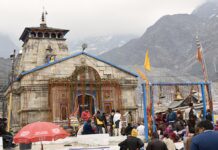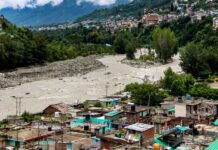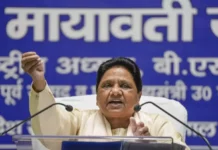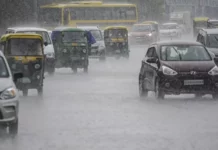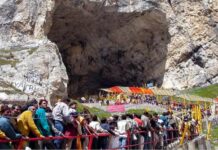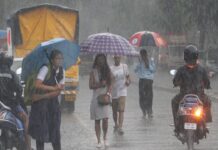The lake of Brahma’s legends
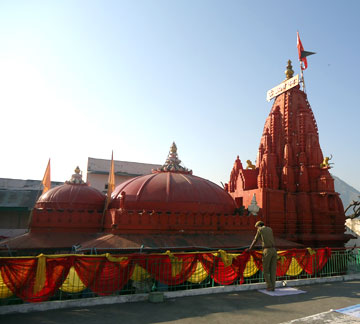 Like all my travels Pushkar too happened on the spur of the moment. When I left home day had not broken yet. By the
Like all my travels Pushkar too happened on the spur of the moment. When I left home day had not broken yet. By the
time we reached Dhaula Kuan to catch the Jaipur bound bus, daylight laid bare huge amounts of waste and litter on one of Delhi’s most important thoroughfares. There were pools of pee in front of the DSOI. And at the bus stand where we stood in the midst of garbage there was that unmistakable stink of urine. Every time I took in the dust and stink I was reminded of those smiling pictures of Madame Dixit in ads that claimed how she had transformed Delhi into a world class city! ‘Madame, there’s a world beyond NDMC, and it stinks!’ I told myself as I grabbed a window seat. After changing buses at Jaipur and Ajmer, night had fallen by the time we reached Pushkar nestled in the lap of undulating hills.
The town surrounds the Pushkar Lake, formed by the percolating rain from the wooded surrounding mountains. I was revisiting Pushkar after a gap of nearly 25 years. Luckily not much has changed. But this time I was here for the famed Animal Fair or what is now popular as the Camel Fair.
In truth the Pushkar Mela has deep spiritual significance. ‘The tourists have subverted it with their Western culture…they have no respect for our ways…’ lamented Vijay Sharma, a resident of Ajmer, my co-passenger. He said we were going to Pushkar on an auspicious day ‘when the Gods have risen’. This was Ekadasi and the elevated state would remain for the next five days till the full moon day or Karthik Poornima, when tens of thousands take a holy dip. This full moon also coincides with the birth of Guru Nanak and is celebrated as Guru Parab among Sikhs and Punjabis.
‘These five days are so auspicious that you can perform any shubhkarya … If as person’s horoscope gives you no auspicious marriage dates you can get married on any one of these days without consulting a pandit,’ Sharma says. Lending credence to his take on a ‘spiritual destination’ the empty bus we boarded for Pushkar was suddenly packed to capacity with village folk headed for the mela – old, men women and children. In less than a half-hour, driving down the winding hill road, we were at Pushkar’s desolate outskirts. Hurtling down the slopes one can reach the lake in five minutes. It was close to ten in the night when went to the lake negotiating narrow lanes dotted with ancient havelis.
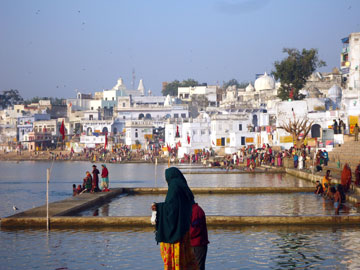
As we scoured the ghats of Pushkar – there are 52 in all – hordes of villagers from distant villages across northern India headed for the cold waters for a cleansing bath. Throughout the night batches of pilgrims arrived in buses and trucks. After a dip they headed for the Brahma temple – Brahma the creator of the universe according to Hindu belief.
The early morning Aarti at the temple is an elevating experience. In all, the small town has over a hundred temples encircling the lake. But for the course of the mela, particularly the last five days of the festival it is the Brahma mandir where everyone is headed. This is said to be the only Brahma temple in the world. Why only one temple to the creator of the universe?
Legend has it that it was a curse from Shiva, the destroyer, to whom Brahma had lied. Another one says that it was his wife Saraswati who cursed him because as he was to take part in a yagna, where she was supposed to be present, not finding her he had married another low caste girl, Gauputri (passed through the gut of a cow to purify her). ‘No one will ever worship you!’ Goddess Saraswati is said to have sworn.
Atop a triangular hill overlooking Pushkar is the Mata Ka Mandir, dedicated to Bhahma’s original wife Saraswati. Even if you are not a believer, a trek to Mata Ka Mandir is highly recommended as it affords a breathtaking view of the lake-town below. Some say the lake was formed when the petals of the blue Ketaki flower fell from Brahma’s hands. Yet another says when Lord Shiva’s wife Sati died he wept so copiously it formed two lakes, one in Pushkar and the other at Ketaksha now in Pakistan. There are many such fascinating legends that make Pushkar one among the holiest of Hindu shrines.
But today Pushkar is better known for the camel fair, which is in fact a fair where chiefly cattle and horses are bought and sold in the run up to Karthik Poornima. The dusty grounds on the fringes of Pushkar draw buyers and sellers of camels and horses from various corners of the desert state.

The owners stay in tents pitched on the sandy grounds while their animals stay tethered outside for buyers to see and bid. We met Rudu Ram of Thaunda village who had a little five-month old pony he was selling for Rs 55 thousand.
Earlier he had sold three horses for as much as 80 thousand each. Not everyone made a fortune. Nearby, in another tent sat Raju and his family, coming from Deoli village some 150 kms away. A Behrupia, he had spent ten days at the festival earning little. Three of his horses had gone for between 10 and 15 thousand.
‘Whatever little we earned has gone into our upkeep here,’ says Raju’s wife. The family will stay the full course of the mela before they return. Atma Ram who had come with his friends from Badgam village some 80 kms away was also downcast. All his friend’s horses were sold, except his.
‘Why?’
‘Red is not a popular color, my horse is red (brown)….White and black are valued here. It is the Rajputs and Banias who prefer white for their marriages,’ says Atma Ram. A tall and healthy white steed can fetch as much as Rs 4 lakhs, while a black one can go for 2 lakhs. The horseshoe of a black horse is popularly used as a charm to ward off the evil effects of Shani or Saturn.
Phool Chand from Jaipur was happily grinning because he had bought a white mare for just Rs. 75,000. ‘She’s pregnant… the pony will also give me good money,’ he said, satisfied with his buy. Waiting for a truck to take his mare home Phool Chand said, ‘Ye chara khaigi…hame bhi khilayegi (we’ll feed her and she’ll feed us).’
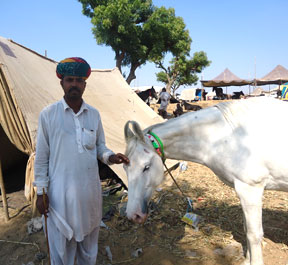 The animal fair, if you can ignore the littered filth, has its fair share of fun and frolic. In the stadium, transformed into a mela ground, camel and horse races are organized on a regular basis during the mela. Rajasthan tourism knows how to sell the state. Also on ‘sale’ were its exotic moustaches in the form of competitors from various corners of the state.
The animal fair, if you can ignore the littered filth, has its fair share of fun and frolic. In the stadium, transformed into a mela ground, camel and horse races are organized on a regular basis during the mela. Rajasthan tourism knows how to sell the state. Also on ‘sale’ were its exotic moustaches in the form of competitors from various corners of the state.
The kind of enthusiastic camera persons (mostly white) it attracted would put an Obama press conference into the shade. A whole batch of people, again firangs, watched the mooch competition from their perch on the back of camels. And after the competition the winners were whisked away into tents where white tourists lived their fantasies and the men with long mushs enjoyed their day of fame. Pushkar also attracts an array of colorful turbans along with the moustaches. Beards, turbans, the colorful ghagra-choli of the women, cows, beggars and sadhus make the jostling walk to the Brahma temple a photographer’s delight.
And what’s a mela without mouthwatering food? Along the road, on display are several local fares like mirchibada, kachoris, samosas and pakoras. There are also the local sweets like rabri, malpua, and others made of pure milk. But competing with the local fare are Lebanese and Italian food like falafel and pizza, not to speak of Israeli and other European dishes.
In fact little cafes with exotic names such as Blue moon, Pink Floyd, catering to ‘foreign tourists’, give a tough competition to local food. It is this blend of East and West, white and brown, holy and unholy, that makes Pushkar both a colorful and mystical destination. Though meat or liquor is banned, the taste of the town lingers long after that hot mirchibada has been washed with a cup of chai.
Ashim Choudhury is author of ‘The Sergeant’s Son’
Ashim Choudhury

